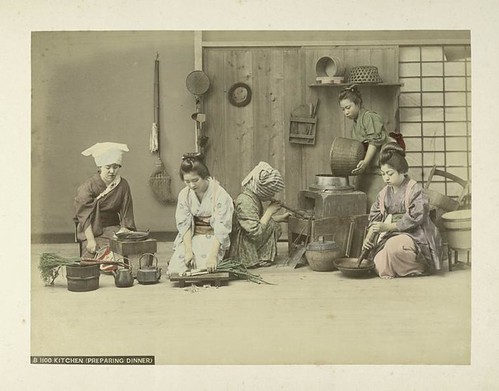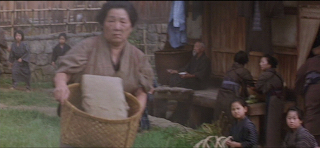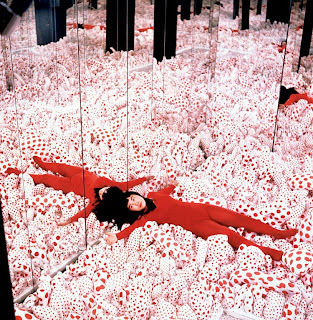Furthermore, this stereotyping of American homegrown values and looks (the self) defines who is outside (other) to the domestic identity. For examples, when a brown or yellow person is depicted in a popular film, he is perpetually, due to a different complexion or eye shape, seen as foreign and therefore other to the normal way of being American. With the rendez-vous of previously isolated countries, each race has fantasized about the other. For example, the circulation of early Japanese photography taken by German, Dutch, and American expatriates and later, Japanese followers, depicted samurai, geishas, public bathhouses, and staged seppuku, those elements of the culture that were most appealing to a Western exotica-buying market. Over 100 years later, however, the same motifs show up in film, because these ideas of Japan are still bestsellers.
Compare early Japanese tourist photos with stills from The Last Samurai:
189-? Kitchen (Preparing Dinner)
2003:

What’s the difference? The Japanese in The Last Samurai appear to be aware of the Westerner present (Tom Cruise), so that’s a step forward from the staged idea (i.e. a false ideal of Japanese preservation of antiquity although modernity was rapidly occurring in Japan) of the absent Western gaze in the 19th century photo.
2003:

No one could deny interaction between Japan and the U.S. today; the former picture, again, frames the Japanese tidily separate from a Westerner; in the latter, the camera follows Cruise as the Japanese man trails behind and listens to
Cruise’s identity issues while other Japanese work the farm.
According to an ideal vision of cinema, popular movie representations neglect to depict cultural differences within and between countries. Despite the existence of Japanese Americans since the birth of film in the 19th century, maintaining the “ideal vision” of a homegenously WASP America required Tom Cruise to play the lead role in a film purportedly about samurais. Filmmaker Kjell Hansen, having first been excited about the idea of a samurai epic, was utterly disappointed by the casting choice of Tom Cruise: "I decided that The Last Samurai was more along the lines of misguided, preposterous, and arrogant...The impression left by the trailer might appeal to those to whom the idea of living in a samurai village with a submissive wife fulfills a certain fantasy of romantic, pastoral purity. The magical transformation of Tom Cruise into the champion of a foreign people also fulfills a power fantasy. To quickly ascend like he did, Cruise must have had something special quality the other warriors did not have." I could not have said it better myself.
Another popular film featuring the character(caricature) of Asia, Memoirs of a Geisha, cast well-received Chinese actresses Zhang Ziyi and Gong Li as Japanese geishas, despite China's resentment of Japan over the Pacific War and Nanking.

Note the book cover's sepia-coloring to make it look more antiquated and the testimonial: “You are seduced completely.”
19th c. photograph
Additionally, parts of Golden’s tale are loosely based on a real-life 20th-century geisha, Mineko Iwasaki, who according to Wikipedia, “felt betrayed by Golden's use of information she considered confidential, as well as the way he twisted reality…[she] denounced Memoirs of a Geisha as being an inaccurate depiction of the life of a geisha.” The reiteration of Far Eastern culture as it was in the past, written and directed by non-Japanese separates these films from Japanese experience, and titillates an American imagination while reinforcing the ideal American as Tom Cruise, and the ideal Asian as an exotic, black-haired, small-eyed foreigner, with no regard for national or cultural differences or the possibility of black-haired, small-eyed people being local and NON-exotic. Consider this reviewer’s ease in believing Memoirs: “What is most surprising about this book is [not] that the author is male and American but that he writes so vividly and accurately through the eyes of a woman in another time and place.[emphasis added]” People can indeed be seduced by the ideas of antiquated customs in a foreign land, whether it represents reality or not.
In contrast to the above examples, when Asians and Asian-Americans represent themselves, they eschew a presentation of an exotic, century-old image of beautiful women isolated by impotent men. Two artists reclaiming their potency, Roger Shimomura and Yasumasa Morimura, display a keen awareness of their racialized Asian male bodies, usually viewed as impotent and feminine, or not depicted at all (e.g. where is Gilmore Girl character Lane Kim’s father?). Morimura represents his toned body in every possible shocking way that upsets color boundaries. It is nude, it has a phallus, it is off-white, and gender shifts.
Yasumasa Morimura,Portrait (Twin), 1988

Morimura,Black Marilyn, 1996
Morimura, Psychoborg, 1994
His choice to mimic controversial boundary-crossers - - Manet’s black servant and non-idealized whore Olympia, Marilyn the iconic peroxide-blonde Norma Jean, and Michael Jackson, the late and great ambivalently-raced musician - - is telling.
Roger Shimomura, How to Tell Your Friends from Japanese-Americans, 2000

Shimomura, Untitled, 1983. Metro Bus Tunnel @ Westlake Station.
**CHECK OUT a ton of SHIMOMURA's work on view now at the Wing Luke Asian Museum now (Sept 11th 2009 through April 18th 2010!**
Asian female bodies have been unable by and large to escape their perceived submissive and exotic otherness. This is a concept inscribed on her body against her will. Judith Butler writes of the process of becoming a proper subject, “I find that the only way to know myself is precisely through a mediation that takes place outside of me, in a convention or a norm that I did not make, in which I cannot discern myself as an author or agent of its making.” This inability to escape one's assignment as abnormal may account for the disappearance of the self-representational bodies of Maya Lin and Jen Liu.
Maya Lin, 2x4 Landscape, 2006, installed at the Henry Art Gallery, Seattle, WA.
Jen Liu, still from video Comfortably Numb, 2006.
A similar sentiment might be felt by artist Maya Lin. Her abstract, nonfigurative design for the Vietnam War memorial (currently reproduced to view at Acacia Memorial Home on Bothell Way, north of Seattle!), did not have a name or face attached to it when selected. But when Ross Perot caught wind of her ethnic background he called her an eggroll: "When twenty-one-year-old Yale student Maya Lin won the competition for the Vietnam War Memorial commission, her profound design, with its black granite displaying a stark list of all the 58,000 Americans who died in the conflict and set into a gash in the earth, was controversial for more than its aesthetics. The selection process was anonymous, and the Ohio-born Lin was identified by only a number until her sketches were selected. Once her face was attached to her art, there were murmurings that she was the wrong choice because she was a 'gook.' For example, businessman Ross Perot, a major promoter of the project, frequently called Lin 'eggroll' and, according to press accounts, 'he hated that she was Asian.'(Wu, 93-95)" No wonder her art does not make a big deal out of her race (i.e. is non figurative of her own body), lest someone be alienated by its eggroll-iness.
New Yorker Jen Liu's art, equal parts American pop-culture and literary fantasy, depicts videos and paintings of Caucasian monks of a fictive ancient cult, and thereby is not directly related to her own body. When Liu's psychotronic work came to the Henry Art Gallery, I had a visitor (who undoubtedly made a point to notice my nonwhiteness) ask me for no apparent reason whether Jen Liu was "Oriental." He proceeded to tell me of his ventures and time spent in Asia, as though his appraisal of my race and her race gave him the right/need/privilege to discuss what he perceived to be Liu's and my shared exotic culture.
During Lacan's mirror stage whereby the child begins to develop the mental image of a virtual form of his body--we could read this virtual body’s “different size” as a different race--the alienating destiny of his future is coming into place, a disconnect between his actual image and his ideal image, or I vs. his ideal-I. The soon-to-be racialized child, then, sees, for example, her chinky, slanted eyes but does not recognize their lower status than round eyes. Like the Lacanian baby, the racialized child perceives that she has mastered her defeat--she still views herself as having the chance of normativity. However, this is an illusion just as the child in the mirror stage perceives mastery over his movement and recognizes his image, but cannot yet control his regular body functions. Once a child learns to speak of her race she has entered the Nom du Pere, or for our purposes, the Law/No of the Patriarch--she is inculcated within the Symbolic order, a racialized subject. She realizes fully her place in the caste system of race and recognizes her difference from the ruling class. She cannot (as she fantasized during the mirror stage) look chinky while being socially normative. The early embedded imago, or external self-image, of whiteness is unattainable though she strongly desires it.
Going back to Baudry, if "ultimately...the 'contents' of the [cinematic] image are of little importance as long as identification remains possible," the developing nonwhite mind, forced to identify with largely non-nonwhite characters, cannot develop any fantasy image of herself other than white. A kid exposed to or coming from a background of engrained psychical racial hierarchy--whether it seeps into her psyche from familly, education, socialization, or entertainment--will begin to racialize her own body and set up her nonwhite body as less than the ideal-I as she is bombarded with imagery of desirable, normative whiteness. She cannot rise above her race in this situation.
Racially psychoanalyzing the aforementioned artists evinces a gender split in representational strategies. Morimura and Shimomura aim to negotiate their bodily position within the Symbolic Order, the order where race rules supreme, proclaiming a large YES! to the "No"s of Patriarchy that denies their manhood and status as a person with a pronounced racial identity, while Lin and Liu’s work, with the disappearance of their bodies, evoke the late mirror stage: due to circumstances beyond their control, they are forced by outsiders and art consumers to recognize their racial position, but their art does not even reference it (not that it should). What then, does the artwork of Yayoi Kusama have to say about her racial body?
Yayoi Kusama, Infinity Mirror Room—Phalli's Field (Floor Show), 1965-98.
Sewn stuffed fabric, board, mirror room without ceiling, 8 x 15 x 15 ft.
Check out her 1967 video Self Obliteration at the SAM through Sept. 7th!!!
It has no such concept of one. Her art, literally insane and therefore not bound to the Law of the Patriarch, refuses to recognize its “position” in any racial/sexual hierarchy. Her body appears surrounded by soft-bodied phalluses, comfortable, languid, but covered as to resist consumption or sexualization. The phallus forms are not colored to match human skin tones, rather they echo a preschooler’s color palette. Her nonsensical picture displays no distinction between race nor sex. The multiplication and all-enveloping nature of the picture plane with mirrors echo an infant’s sense of an eternal bond with the mother, as a child with other children before it gains recognition of such a thing as race. Kusama and pre-racial, pre-subjectified children are deliciously blissful.
Žižek suggests an implosion rather than the (impossible) destruction of stereotypes. Regarding the role of desire in racial limitations, he states that "desire is absence while libido-drive is presence." That is to say that a person who is being desired needs to be absent in order to be desired, while the incongruous, flawed, and sometimes ugly "whole package" of a real person, (a libido-drive) presents itself warts and all. Considering the absence of Japanese in the writing of Last Samurai or Memoirs, or in the aforementioned list of productions limited to one Asian each, clearly, any Asian or Asian American agency or libido-drive is saliently obscured. Žižek proposes that rather than erasing the possibility of racial difference, and thereby assuming everyone is white by default--or should be--that we can present the fallacy of the fantasy and the reality in their contradictory nature--to undermine the artifice of race altogether. This means that entertaining and moneymaking fairytales of race will continue, but taken with knowledge of versions such as Morimura's or Lin's-that upset the idea of the foreign exotic Asian, untouched by the West, but existing to be fantasized about by it.
Repeatedly recognizing one’s own non-normativity within a framework of the “ideal vision” of cinema, then, sets up the ideal-I as unattainable, as well as precluding a regression to a jouissance state of pre-racial nexus. Asians, Asian Americans, and nonwhites may internalize their position in the hierarchy if not nurtured to cherish their own ethnic background as beyond very shallow sidekick characters.
Sources:
- Baudry, Jean-Louis. "Ideological Effects of the Basic Cinematographic Apparatus." In Film Theory and Criticism: Introductory Readings, edited by Leo Braudy and Marshall Cohen, 355-365. New York: Oxford University Press, 2004.
- Butler, Judith. "Giving an Account of Oneself." Diacritics 31, no. 4 (2001):22-40. http://www.jstor.org/stable/1566427.
- Dyer, Richard. "The matter of whiteness." In White, 1-14. London: Routledge, 1997.
- Guerrero, Ed. "The Rise and Fall of Blaxploitation." In Framing Blackness: The African American Image in Film, 69-111. Philadelphia: Temple University Press, 1993.
- Hansen, Kjell. "Lost in the West." 2005.
- Lacan, Jacques. "The mirror stage as formative of the function of the I as revealed in psychoanalystic experience." http://www-class.unl.edu/ahis498b/parts/week5/mirror.html.
- The Last Samurai. Directed by Edward Zwick. Burbank, CA: Warner Home Video, 2004. DVD.
- Wu, Frank. Yellow: Race in America beyond Black and White. New York: Basic Books, 2001.
- Žižek, Lacan. "Love Thy Neighbor? No, Thanks!" In The Psychoanalysis of Race, edited by Christopher Lane, 154-175. New York: Columbia University Press, 1998.
- More on Asians and Barbies (but to be fair, there is no American Indian or Arab Barbie mentioned either)
- Paul Mooney on race in Movies and The Last Samurai
- (6/15/10) Messed up racial doll preference in nonwhite children: here and here


Smart Hannah. My atrophied post-academic brain stumbled a few times on this but with the help of online dictionaries has been sufficiently and delightfully stimulated. and totally impressed.
ReplyDeletehope you are well! wonderful writing,
KJ
thanks! Glad to have you as a cohort in nerdiness.
ReplyDeleteTalk about timely! Maya Lin's Vietnam Memorial is gone but you can still see Kusama at SAM's Target Practice through the 7th, and coming up next Roger Shimomura at Wing Luke.
ReplyDeletelink
Hannah, I had always thought of Maya Lin's work more in terms of landscape than as an effacement of representation. I guess you weren't saying that exactly, but I think you were suggesting her work comes out of some kind of strategy of avoidance.
ReplyDeleteI wish I hadn't missed the replica of the Vietnam Veterans Memorial when it was here (should have read your post back in August). I travelled to see the original one when it opened, back in 1980 if I recall?
Yes, I missed it too unfortunately! I've never been to the original. I'm not saying that Maya Lin CONSCIOUSLY makes this decision to efface her bodily representation, perhaps this is not in her mind at all. It's just an idea of mine, a possibility.
ReplyDelete